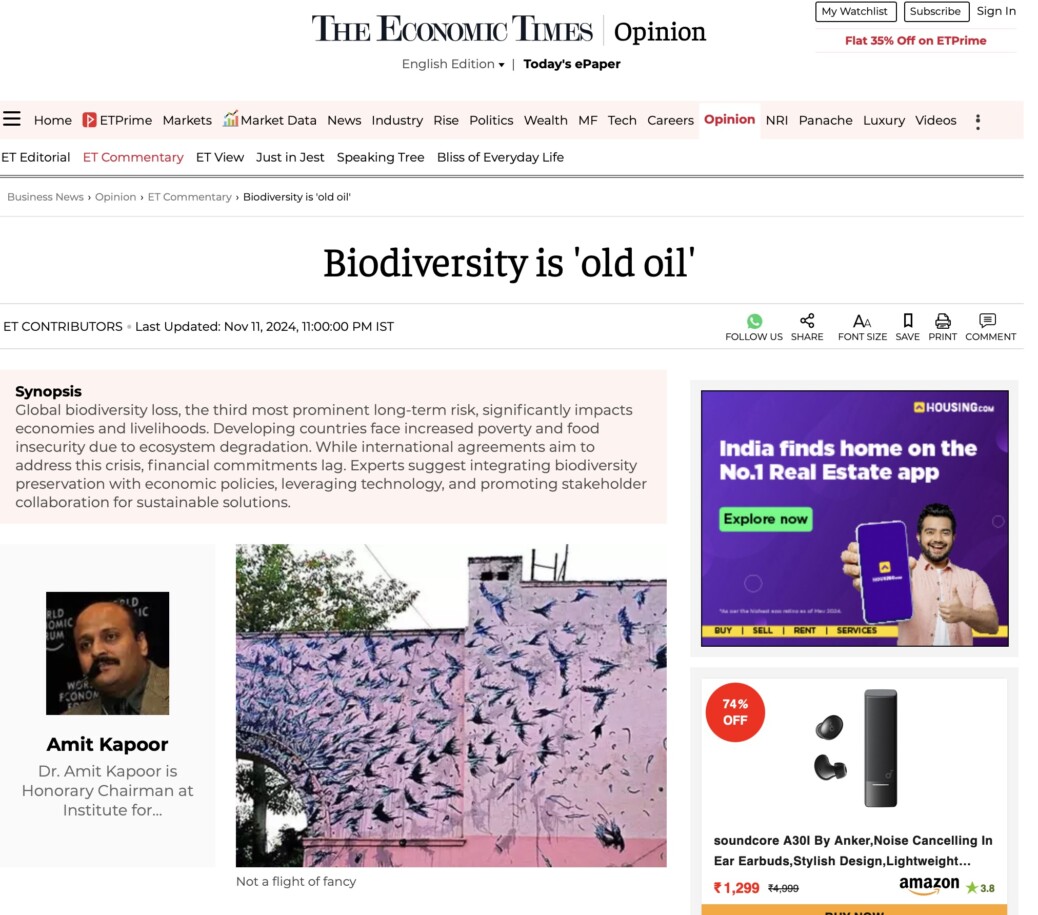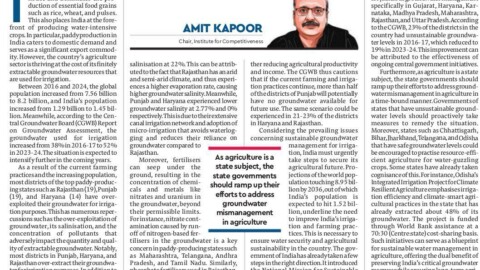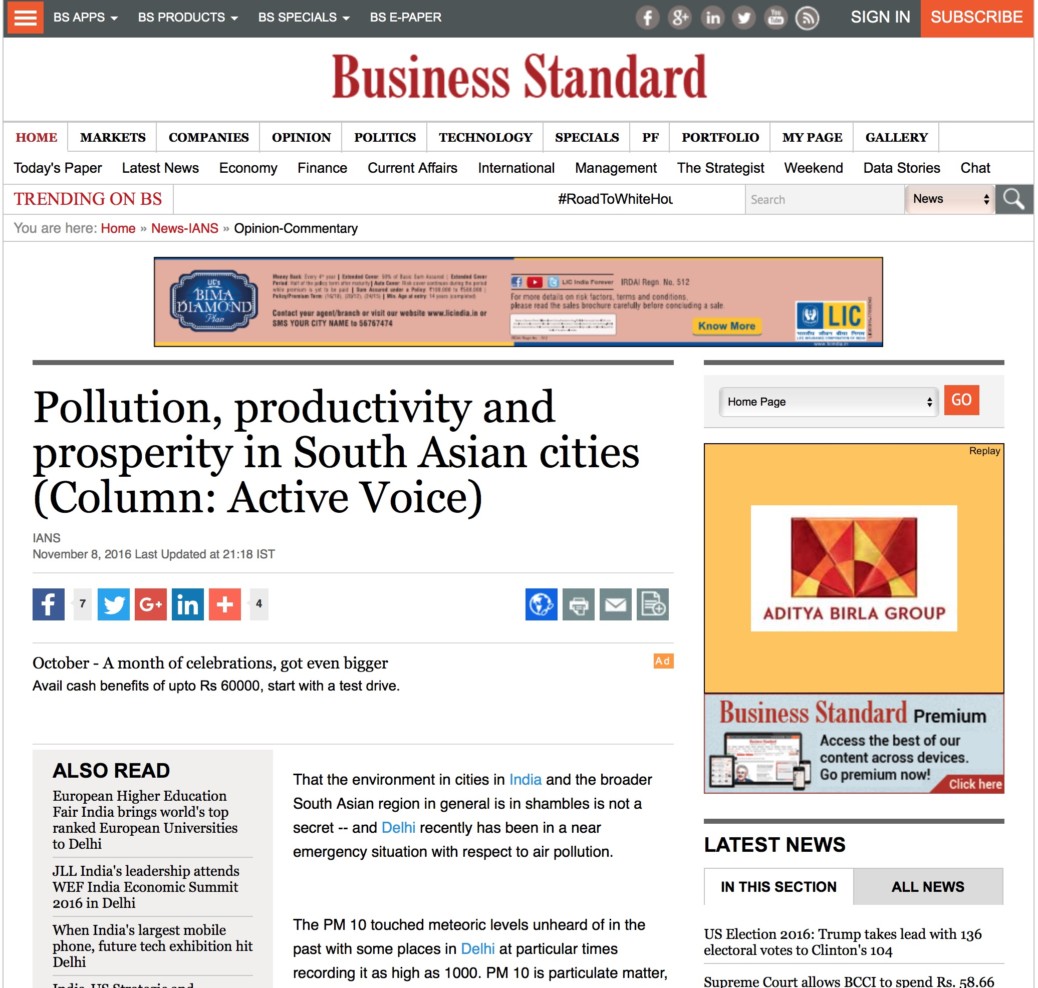By Amit Kapoor and Inputs from Vidhi Tiwari
Economics of Biodiversity Losses: Perspective on Conservation and Costs
The ongoing Anthropocene has altered the landscape of our planet in an unprecedented manner, the manner of utilizing the natural resources has led to the Triple Planetary Crisis consisting of climate change, pollution and biodiversity loss. These risks related to environment have emerged as the dominant group of risks with biodiversity loss and ecosystem collapse appearing as the third most prominent long-term risk in the Global Risks Report 2024. At present, the rate of biodiversity loss is fastest in the recorded time periods, and nearly one in every four species assessed is threatened as per the United Nations. Provided the rise in the demand of resources expected to increase by 60 percent by 2060 from 2020 levels as per UNEP, it is pertinent to prevent and mitigate the grim implications of biodiversity loss.
Often the economic prosperity and aspects of nature conservation are perceived in a zero-sum equation where compromise on one would lead to increase in another. However, the emerging and more mature understanding of the issue indicates towards a more nuanced relationship. The services provided by ecosystems are widespread ranging to both tangible and intangible kind, and this link between economic output and biodiversity is supported by large set of evidence. For example, WEF establishes that nearly half of global GDP amounting to USD 44 Trillion is significantly dependent on ecosystem services, while UNCTAD identifies nearly 17 percent of global exports as bio-originated products directly linked to biodiversity and ecological health of environment.
Human activities related to food production, infrastructure, energy generation and mining are identified as the sectors responsible for around 79 percent of the impact on threatened species by the IUCN. Since all economic outputs are dependent on nature, although in varying degrees, the economic and financial consequences of ecosystem degradation including supply chain disruptions, risks to physical capital, increased cost of business etc. are particularly concerning. Even decline of a single species can result in significant environmental, social, cultural and importantly, economic setbacks for a country. For instance, the rapid fall in the vulture population in India caused damages to human health and ecosystem which are quantified at around USD 69.4 billion per year in a study at the University of Chicago. Evidently, biodiversity as a source of ecosystem services is an essential component of natural capital, making it a potential catalyst in determining economic well-being of the populations across the globe.
The impacts of biodiversity loss and species extinction become more profound when its unequal impacts are assessed. The developing countries risk increased poverty and food insecurity due to loss of livelihood and robust food sources. Biodiversity degradation can lead to losses equivalent to 2.3 percent of global GDP annually by 2030, with highest negative impact on the real GDP of Sub-Saharan Africa and South Asia. The situation becomes more precarious as low-income countries risk loss of 10 percent of their respective GDP according to the World Bank and are more vulnerable to economic shocks prompted by loss in biodiversity. IUCN also highlights the vulnerability of nearly 1.6 billion people to the negative impacts of biodiversity loss, mostly located in the developing world. It is a cause of concern that the markets of developing world are more reliant on the natural capital compared to developed countries, and the absence of robust policy tools and economic resources to affect the biodiversity significantly limits the capacity of these countries to act. The close relationship of biodiversity with climate change adds to the logic of assigning it priority in policy making, both at national and international level.
Recognizing the importance of the issue, many frameworks have been crafted and initiatives have been conceived to prevent and mitigate the biodiversity loss, including the adoption of the recent Global Biodiversity Framework in 2022. The challenges, however, persist in delivering to the goals of these instruments. To substantiate, the international community has not only lapsed in its commitment to prevent biodiversity losses but has exceeded the long-term targets related to land use by an alarming six times as per the World Resources Outlook. The UN Global Land Outlook warns that inaction on biodiversity loss may cause the extinction of nearly one million species of flora and fauna in near future, which may trigger a larger set of events affecting socio-economic well-being.
The recent CBD COP 16 at Cali emerged as the largest biodiversity COP till date and concluded with establishment of a permanent body to ensure the participation of local and indigenous communities in biodiversity protection, and an inception of a global fund to leverage digitally sequenced genetic data for equitable benefit of all. While the inclusive approach is a step in the right direction, the performance on finance commitments lagged at 0.2% (USD163 million) of the target (USD200 billion) under the Global Diversity Framework indicating to a need to inculcate better environmental investment strategies.
There is an obvious urgency to act on preserving the biodiversity with multipronged tools as the conservation efforts alone have been unable to prevent this phenomenon. The use of advanced technology, synergy among multiple stakeholders, realistic and effective policy goals, innovation in high impact areas, restructured business regulations to allocate attention to the issue of biodiversity loss etc. are some areas worth exploring to enable biodiversity. We must understand that the cost of replacing the ecosystem services, are far more than that of preserving those. For instance, as per WEF urban planning with nature-positive infrastructure can lead to creation of eco-bridges while also generating 38 million employment opportunities by 2030 globally.
Further, the measures need to inculcate the understanding that the loss of natural capital cannot be replaced in totality by anthropogenic capital. The flexibility needs to be accorded in the policy tools to accommodate the solutions to often invisible but long-term implications of depletion of biodiversity. Finally, the laws and institutional design should be strengthened at all levels to foster greater accountability for maintaining and enhancing biodiversity.
The connection between human well-being and environmental sustainability has gained more weight than ever, and the necessity to pursue economic goals with a lens of green growth is the need of hour. An integrated approach to address economic prosperity and enabling biodiversity together can translate into tangible and lasting outcomes for the humankind, ensuring sustainability in our future.
The article was published with Economic Times on November 12, 2024.























